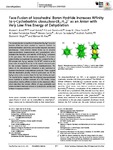Mostrar o rexistro simple do ítem
Face-Fusion of Icosahedral Boron Hydride Increases Affinity to γ‐Cyclodextrin: closo,closo‐[B₂₁H₁₈]⁻ as an Anion with Very Low Free Energy of Dehydration
| dc.contributor.author | Assaf, Khaleel I. | |
| dc.contributor.author | Holub, Josef | |
| dc.contributor.author | Bernhardt, Eduard | |
| dc.contributor.author | Oliva‐Enrich, Josep M. | |
| dc.contributor.author | Fernández-Pérez, María-Isabel | |
| dc.contributor.author | Canle, Moisés | |
| dc.contributor.author | Santaballa, J. Arturo | |
| dc.contributor.author | Fanfrlík, Jindřich | |
| dc.contributor.author | Hnyk, Drahomír | |
| dc.contributor.author | Nau, Werner M. | |
| dc.date.accessioned | 2020-05-19T08:44:59Z | |
| dc.date.available | 2020-05-19T08:44:59Z | |
| dc.date.issued | 2020-03-12 | |
| dc.identifier.citation | K. I. Assaf, J. Holub, E. Bernhardt, J. M. Oliva-Enrich, M. I. Fernández Pérez, M. Canle, J. A. Santaballa, J. Fanfrlík, D. Hnyk, W. M. Nau, ChemPhysChem 2020, 21, 971 | es_ES |
| dc.identifier.issn | 1439-7641 | |
| dc.identifier.uri | http://hdl.handle.net/2183/25594 | |
| dc.description.abstract | [Abstract] The supramolecular recognition of closo,closo‐[B₂₁H₁₈]⁻ by cyclodextrins (CDs) has been studied in aqueous solution by isothermal titration calorimetry and nuclear magnetic resonance spectroscopy. These solution studies follow up on previous mass‐spectrometric measurements and computations, which indicated the formation and stability of CD ⋅ B₂₁H₁₈⁻ complexes in the gas phase. The thermodynamic signature of solution‐phase binding is exceptional, the association constant for the γ‐CD complex with B₂₁H₁₈⁻ reaches 1.8×10⁶ M⁻¹, which is on the same order of magnitude as the so far highest observed value for the complex between γ‐CD and a metallacarborane. The nature of the intermolecular interaction is also examined by quantum‐mechanical computational protocols. These suggest that the desolvation penalty, which is particularly low for the B₂₁H₁₈⁻ anion, is the decisive factor for its high binding strength. The results further suggest that the elliptical macropolyhedral boron hydride is another example of a CD binder, whose extraordinary binding affinity is driven by the chaotropic effect, which describes the intrinsic affinity of large polarizable and weakly solvated chaotropic anions to hydrophobic cavities and surfaces in aqueous solution. | es_ES |
| dc.description.sponsorship | K.I.A. and W.M.N. are grateful to the DFG for grant NA-686/8 within the priority program SPP 1807 “Control of London Dispersion Interactions in Molecular Chemistry”. J.H., J.F., and D.H. thank the Czech Science Foundation (grant number 17-08045S) and M.I.F.P., M.C.L, and J.A.S.L. thank the regional government Xunta de Galicia for financial support (Project Grupo Potencial Crecemento -GPC- ED431B 2017/59). J.M.O.-E. acknowledges financial support from the Spanish MICINN through project CTQ2018-094644-B-C22 | es_ES |
| dc.description.sponsorship | German Research Foundation; NA‐686/8 | es_ES |
| dc.description.sponsorship | Czech Science Foundation; 17‐08045S | es_ES |
| dc.description.sponsorship | Xunta de Galicia; ED431B 2017/59 | es_ES |
| dc.language.iso | eng | es_ES |
| dc.publisher | Wiley | es_ES |
| dc.relation | info:eu-repo/grantAgreement/AEI/Plan Estatal de Investigación Científica y Técnica y de Innovación 2017-2020/PGC2018-094644-B-C22/ES/DISEÑO Y CARACTERIZACION DE NUEVOS MATERIALES MOLECULARES Y OPTIMIZACION DE FARMACOS: SINERGIA EXPERIMENTO Y TEORIA/ | |
| dc.relation.uri | https://doi.org/10.1002/cphc.201901225 | es_ES |
| dc.rights | Atribución 4.0 Internacional | es_ES |
| dc.rights.uri | http://creativecommons.org/licenses/by/4.0/ | |
| dc.subject | Anion binding | es_ES |
| dc.subject | Boron clusters | es_ES |
| dc.subject | Desolvation | es_ES |
| dc.subject | Host-guest chemistry | es_ES |
| dc.subject | Intermolecular interactions | es_ES |
| dc.title | Face-Fusion of Icosahedral Boron Hydride Increases Affinity to γ‐Cyclodextrin: closo,closo‐[B₂₁H₁₈]⁻ as an Anion with Very Low Free Energy of Dehydration | es_ES |
| dc.type | info:eu-repo/semantics/article | es_ES |
| dc.rights.access | info:eu-repo/semantics/openAccess | es_ES |
| UDC.journalTitle | ChemPhysChem | es_ES |
| UDC.volume | 21 | es_ES |
| UDC.issue | 10 | es_ES |
| UDC.startPage | 971 | es_ES |
| UDC.endPage | 976 | es_ES |
| dc.identifier.doi | 10.1002/cphc.201901225 |
Ficheiros no ítem
Este ítem aparece na(s) seguinte(s) colección(s)
-
GI-REACT! - Artigos [103]






